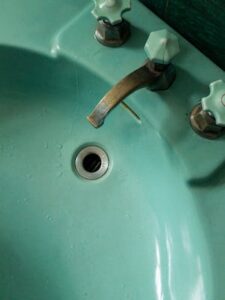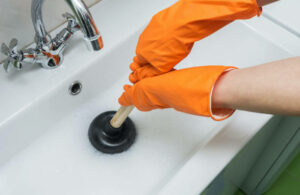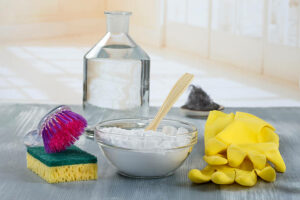A sink is an essential fixture in any kitchen or bathroom, serving as a designated area for water usage and drainage.
It plays a vital role in everyday activities such as washing dishes, preparing food, or personal hygiene. Sinks come in various shapes, sizes, and materials, catering to different functional and aesthetic preferences.
Functionally, a sink consists of a basin or bowl-shaped container, usually made of materials like stainless steel, porcelain, or composite materials.
It is connected to a water supply system, allowing water to flow into the basin. Beneath the basin, there is a drain that collects used water and directs it to the plumbing system for disposal.
Sinks are available in different configurations to suit diverse needs. Single-bowl sinks are common and offer a single basin for washing and rinsing. Double-bowl sinks feature two separate basins, providing the convenience of multitasking or dividing tasks like washing and rinsing.
Additionally, some sinks have additional accessories like cutting boards or drying racks to enhance their functionality.
In terms of aesthetics, sinks contribute significantly to the overall design and style of a kitchen or bathroom. They come in a range of shapes, including rectangular, round, or square, and can be mounted in different ways.
Undermount sinks are installed below the countertop, providing a seamless appearance and easy cleaning. Top-mount or drop-in sinks are mounted on top of the countertop, creating a visible rim around the basin.
When selecting a sink, factors such as durability, maintenance, size, and style should be considered. Stainless steel sinks are popular due to their durability, affordability, and resistance to stains and corrosion.
Porcelain sinks offer a classic, elegant look but may require more maintenance to prevent chipping and staining. Composite materials provide a blend of durability and design options.
A clogged sink can be a frustrating and inconvenient problem to deal with. Whether it’s due to accumulated debris, grease buildup, or foreign objects lodged in the drain, unclogging a sink is a task that many homeowners encounter at some point.
Fortunately, with a little patience and some basic tools, you can easily unclog a sink and restore proper drainage. In this article, we will walk you through a step-by-step guide on how to unclog a sink effectively.
Materials Needed:
- Plunger
- Rubber gloves
- Bucket or bowl
- Baking soda
- Vinegar
- Boiling water
- Pipe wrench or pliers (optional)
- Wire hanger (optional)
Step 1: Prepare the area

pexels.com
Start by clearing out the area under the sink and removing any items that might obstruct your access to the pipes. Place a bucket or bowl beneath the trap or P-trap (curved pipe) to catch any water or debris that may spill out during the unclogging process.
Step 2: Try the plunger

istockphoto.com
If your sink has an overflow drain, cover it with a wet cloth or tape to ensure proper suction. Put on rubber gloves to maintain hygiene, and then position the plunger over the drain, making sure it forms a tight seal. Push down gently and begin plunging vigorously for about 15-20 seconds. Repeat this process several times until the water starts draining or the clog is dislodged.
Step 3: Use the baking soda and vinegar method

istockphoto.com
For this natural and eco-friendly method, start by pouring half a cup of baking soda down the clogged drain. Follow this with half a cup of vinegar. The mixture will create a chemical reaction, causing fizzing and bubbling. Cover the drain with a cloth or stopper to contain the reaction. Allow it to sit for about 15-20 minutes. Finally, flush the drain with boiling water to clear out the clog.
Step 4: Clear the trap or P-trap

istockphoto.com
If the clog persists, the blockage might be located in the trap or P-trap beneath the sink. Place a bucket or bowl beneath the trap to catch any water. Use a pipe wrench or pliers to loosen the slip nuts on both ends of the trap. Once the nuts are loose, carefully remove the trap and inspect it for any debris or obstructions. Clean out the trap using a wire brush or by hand, removing any trapped debris. Reinstall the trap and tighten the slip nuts securely.
Step 5: Employ a wire hanger

istockphoto.com
If the clog is still stubborn, you can fashion a makeshift tool using a wire hanger. Straighten out the hanger and create a small hook at one end. Insert the hooked end into the drain and gently maneuver it around to catch and pull out any obstructions. Be cautious to avoid scratching or damaging the pipes.
Step 6: Seek professional assistance

istockphoto.com
If all the previous steps fail to unclog your sink, it may be time to contact a professional plumber. They have the necessary expertise and tools to handle more severe clogs or complex plumbing issues.
A clogged sink doesn’t have to ruin your day. By following the step-by-step guide outlined in this article, you can tackle most sink clogs with ease.
Remember to start with the simpler methods, such as plunging and using baking soda and vinegar, before moving on to more involved techniques like removing and cleaning the trap.
However, if you’re unsure or uncomfortable with any step, it’s always best to consult a professional plumber to avoid any further damage to your plumbing system.


